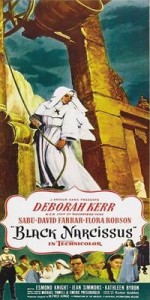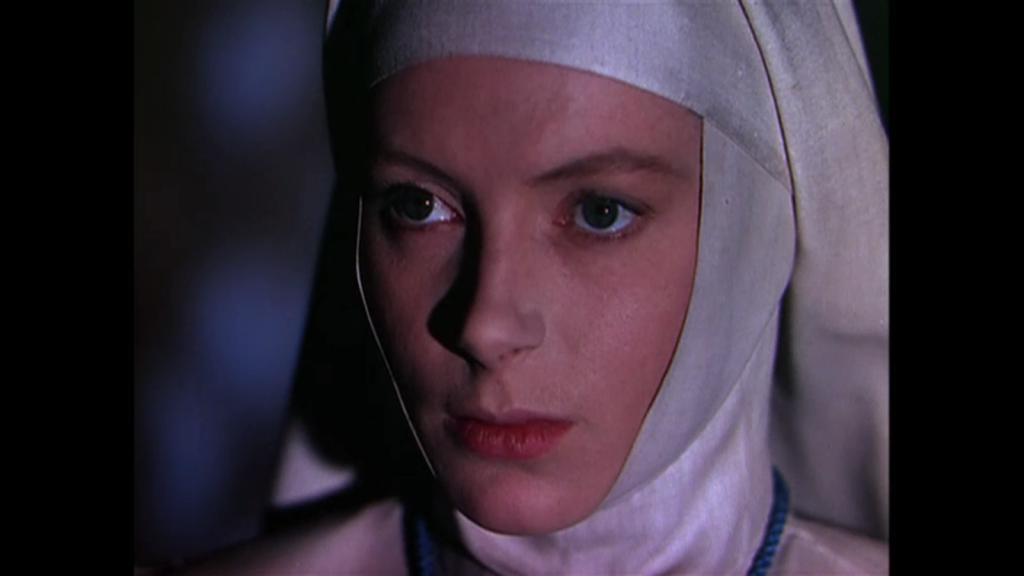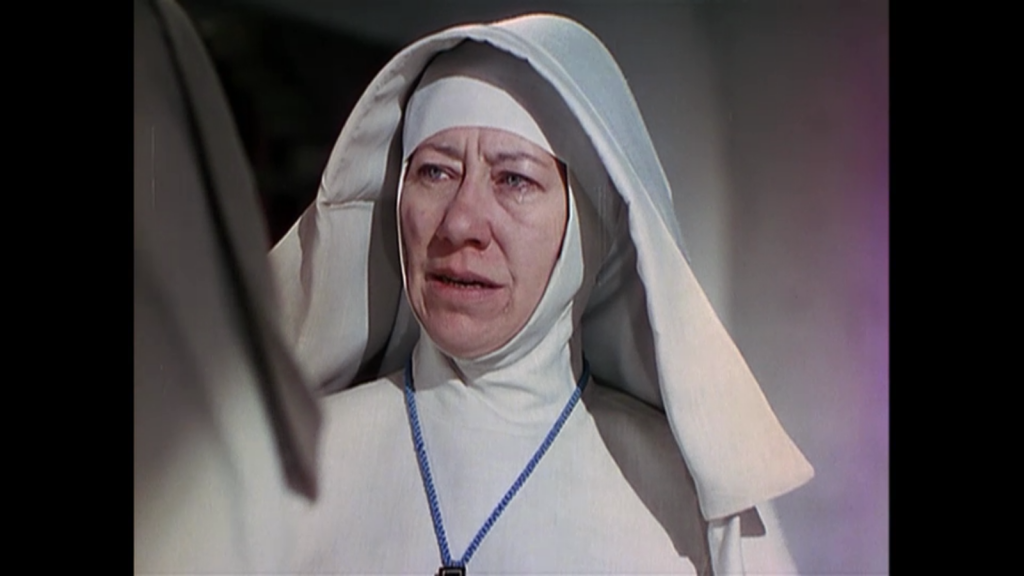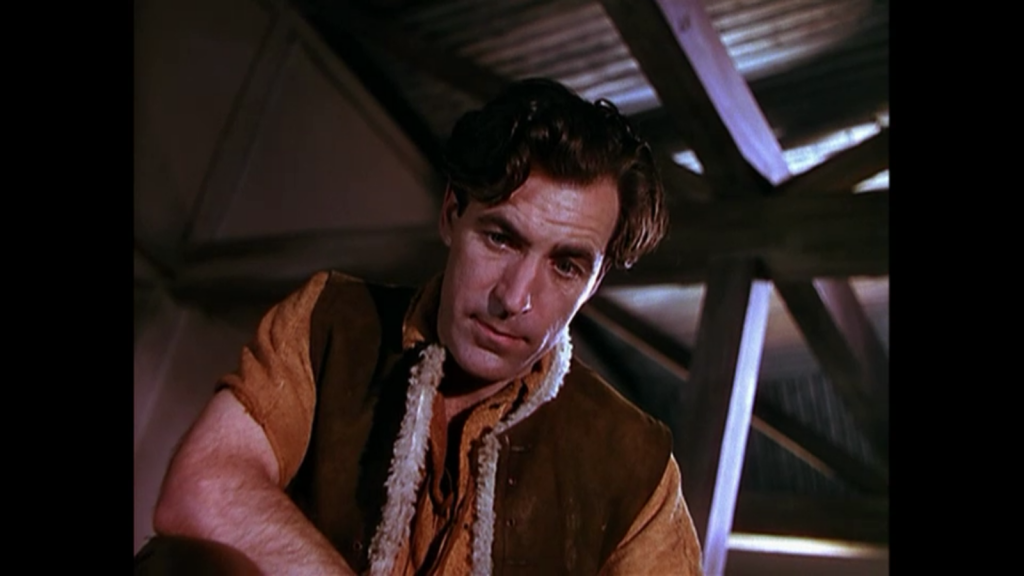|

Synopsis:
A nun (Deborah Kerr) is sent to establish a convent high in the Himalayas, where she and her fellow nuns — Sister Philippa (Flora Robson), Sister Honey (Jenny Laird), Sister Briony (Judith Furse), and Sister Ruth (Kathleen Byron) — each confront their personal demons.
|
|
Genres, Themes, Actors, and Directors:
- Deborah Kerr Films
- Flora Robson Films
- India
- Jean Simmons Films
- Mental Breakdown
- Michael Powell Films
- Nuns
- Sabu Films
Response to Peary’s Review:
The opening line of Peary’s review of Black Narcissus simply exclaims, “An erotic masterpiece about nuns!” Indeed. The creative team of Michael Powell and Emeric Pressburger managed to produce a remarkably “intense adaptation of Rumer Godden‘s novel”, in which a youthful head sister (Kerr) and her four charges “find their commitment to the order greatly tested” as they’re placed in “an exotic setting” — a former “residence of a potentate’s harem… situated on an isolated mountain ledge” which is “dark and haunted by its sinful past”, and where “an eerie wind blows constantly through the empty corridors”. Peary accurately argues that the picture “is splendidly acted, uncompromisingly written…, and ranks as one of the most stunningly beautiful color films of all time, thanks to cinematographer Jack Cardiff” (about whom a recent must-see documentary — Cameraman: The Life and Work of Jack Cardiff [2010] — was just released) “and art director Alfred Junge“. Yet as Peary notes, “viewers” (myself included) “are usually shocked to discover that for the most part the picture was made inside a studio so that Cardiff could better establish the nuns’ terrible sense of claustrophobia”.
In his Alternate Oscars, Peary awards Kerr Best Actress of the Year — after venting about how that year’s Oscar was “wasted” on Loretta Young, who “made only a half-dozen noteworthy movies, and wasn’t all that impressive in any of them”, though he jokingly concedes perhaps she “deserved an Emmy for years of twirling through a door without once ripping her dress as the hostess of… The Loretta Young Show” — ouch! At any rate, in this text, Peary lauds Kerr’s ability to “not… let Kathleen Byron overwhelm her in a much showier part”; yet while Kerr holds her own admirably — she does phenomenal, subtle work representing her character’s emotional arc throughout the narrative — it’s hard to deny that Byron is the protagonist who first comes to mind when thinking back on this film. Her mental derangement — so brilliantly filmed and conceived by all involved (including the make-up artists; see stills below) — provides an unforgettable climax to a truly unique film, one which (surprisingly enough) may ultimately best “belong” to the horror genre (as suggested so persuasively by DVD Savant).
Redeeming Qualities and Moments:
- Deborah Kerr as Sister Clodagh (voted Best Actress of the Year in Peary’s Alternate Oscars)

- Kathleen Byron as Sister Ruth

- Flora Robson as Sister Philippa

- David Farrar as Mr. Dean

- Stunning cinematography by Jack Cardiff

- Alfred Junge’s production design

- The surreal climax

Must See?
Most definitely. Nominated as one of the Best Pictures of the Year in Peary’s Alternate Oscars.
Categories
- Genuine Classic
- Important Director
- Noteworthy Performance(s)
- Oscar Winner or Nominee
(Listed in 1001 Movies You Must See Before You Die)
Links:
|








2 thoughts on “Black Narcissus (1947)”
An absolute must – a gift that keeps on giving!
To remark on the assessment given, I don’t know that I’d say the nuns confront “personal demons”. Nor would I think that the ‘haunting’ that goes on throughout the film has much to do with the “sinful past” of the former harem. (But, of course, thankfully the film’s real meaning is open to interpretation.) What I get from a number of viewings is that at least three of the nuns are overtaken by a lingering, ever-present spirit of sensuality which they all have difficulty facing and coping with. (The other two nuns seem somewhat immune – do they lean toward the asexual? – but what else could cause the mute character Jean Simmons plays to suddenly dance so fluidly around a room for no apparent reason?)
For me, basically the film puts into question the ‘wisdom’ of living a monastic life completely removed from physical intimacy. (Why else would Sister Ruth go mad?)
Whenever I return to this film – which I do from time to time – I’m always amazed by it for a number of reasons. First of all because it is so breathtakingly beautiful. (I do wonder whether the decision to make it a studio film had more to do with the aim of a claustrophobic atmosphere than a budget making the cost of location shooting prohibitive.) The technical aspects and the way the film is shot from start to finish are nothing short of miraculous. One could almost watch this movie with the sound off and bathe in the visuals – they are in no short supply! (Kathleen Byron in all that RED!). But, of course, you wouldn’t really want to do that because the film is such a complete package: everything works together here quite perfectly.
And I’m also amazed at how, each time, the film seems to fly by – much like ‘The Wizard of Oz’, in a way. (I think they have a similar running time.) It just kind of takes off and, before you know it, it’s over. And, of course, there are the pitch-perfect performances. (Has Sabu ever been better?)
Watching ‘Black Narcissus’ – one of my favorite film titles; which, we learn, is the name of a scent (again, the theme of sensuality) – is like treating yourself to a full-course movie meal, including dessert with coffee. It’s a very rich film experience. Simultaneously bold and subtle, I daresay this is a real film fanatic’s film!
NOTE: The first several times I saw this film, it was an early American release version which excised all of Kerr’s pre-nun scenes. I didn’t see a complete version until I moved to Tokyo and saw an uncut version on VHS.
One of the all-time greats – and once again thanks to Mr Peary for pointing me towards it all those years ago.
I wanted to say something about his remark about Loretta Young which is uncharacteristically mean-spirited. I can only think he’d not seen many of Young’s earlier films, especially those made in the first half of the 1930s. The ‘discovery’ of pre-coders has led to many films of that era emerging from the vaults where that were probably locked away when Peary was writing. Young is a relaxed, witty and sexy presence in any number of films from that time. The contrast with most of her later roles is quite stark – but then the same could be said about, for example, Irene Dunne whose 1940s’ films are mostly stodgily self-important.